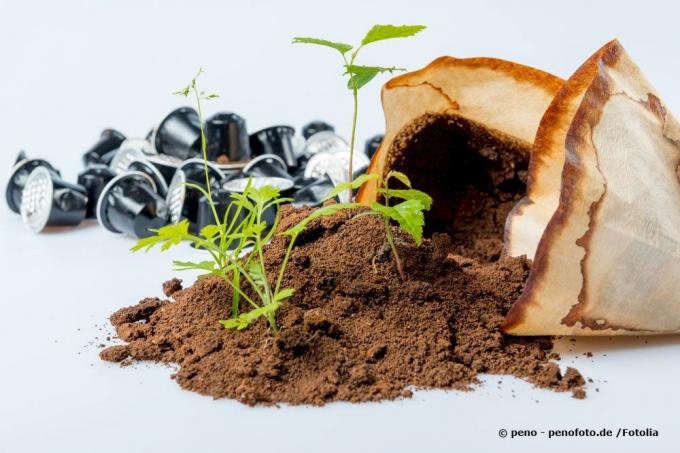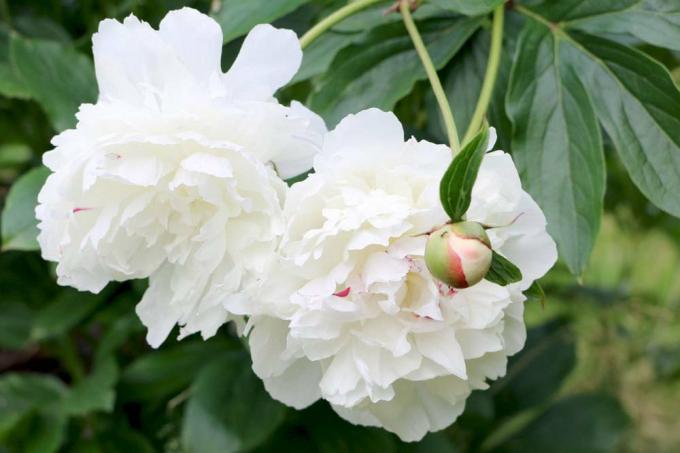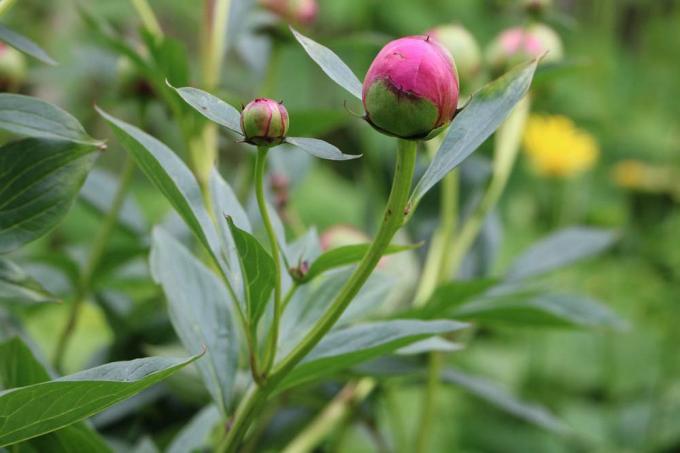
table of contents
- Fertilize peonies
- time
- preparation
- 5 natural home remedies to use as peony fertilizers
- 1. compost
- 2. Slightly rotted manure
- 3. Coffee grounds
- 4. Horn shavings
- 5. Bone meal
- Mulching
Robust, picturesque flowers and an early flowering period at the beginning of May make up the Paeonia. Peonies have been inspiring people for centuries because of the floral decorations and are often found in monastery gardens or parks. The round, rose-like flowers are a real eye-catcher in your own garden. In order to support the flower formation and high robustness of the peony, it is important to fertilize it. As a fertilizer, home remedies are of course ideal for these.
Fertilize peonies
First of all, the question must be clarified whether it is even necessary to fertilize peonies. The peony family (bot. Paeoniaceae) are extremely frugal plants and only need the right location in order to bloom anew every year and to survive the winter. Especially the peasant or common peony (bot. Paeonia officinalis) is easy to grow in Germany. Despite this ideal adaptation, you should not do without fertilizers. However, you need to fertilize much less than you might think:
- do not fertilize again in the year of planting
- from the 2nd Year is fertilized
time
Since the plants are Weak eaters you generally need very little fertilization. If the location is precisely adapted to the needs of the plant, it is sufficient to administer nutrients only once in spring shortly before the new budding. You can recognize the shoot by the red stems that grow out of the site. As soon as these show up, the right time has come. For the rest of the year, you have two options for fertilizing the plants:
1. After the first fertilization in spring, you can apply small amounts of fertilizer every four weeks until the end of August or beginning of September. It is just important not to overdo it, otherwise the “roses” will quickly become over-fertilized, even if the remedy is natural.
2. Alternatively, distribute a larger amount in July to provide the plant with sufficient nutrients. This amount should be about the same as in spring and is sufficient to prepare the crop for the coming winter.
You must never distribute the nutrients at the end of summer, otherwise there will be an excess and the peonies cannot go into hibernation. This would stress them unnecessarily and either delay budding in the following spring or even damage the peony. Over-fertilizing Paeonia happens very quickly and the pretty plants can sometimes find it difficult to recover. Therefore, you should pay particular attention to not too late to fertilize.
preparation
Before you can work the following fertilizers into the soil, you need to prepare the location of the peonies. This is used to loosen up the soil, improve air circulation and the nutrients can be easily distributed. The following steps make it easy to prepare the site for fertilization:
- Remove weeds from the site
- just steal a lot of nutrients from the peonies
- Loosen up the earth
- It is best to use a hand cultivator for this
- larger tools could injure the delicate roots
- especially loosen up the soil around the plant
- The fertilizer will later be incorporated into this
When preparing, be careful not to choose a day that is too dry. If the soil is too dry, you could accidentally damage the roots. The peony does not mind a wet fertilization time at all.
tip: When preparing, be careful not to damage the roots of the peonies. These are very sensitive and can quickly wither as soon as they have been processed too impetuously.
5 natural home remedies to use as peony fertilizers
When looking for a suitable peony fertilizer that is organic or natural, consider using classic fertilizers and home remedies. You can and should refrain from the use of artificial fertilizers, as these do not really have a positive effect on the stone-crusher-like (. Saxifragales). Biological fertilization makes more sense, because artificial fertilizers usually cause more damage to the plants, especially if it is a product with a high content of minerals. For this reason, you should rely on one of these fertilizers for your peonies:
1. compost
Well-ripened household compost is an ideal source of nutrients for your peonies. You can decide for yourself what ends up on the compost and thus passed on to the peony. Compost that has ripened very well and no longer contains many coarse components is particularly suitable. Above all, give preference to animal ingredients, as these contain more nitrogen, which will please the peonies. You can even let your fingernails and toenails rot on the compost. The compost is distributed in the following way:
- check for pests and fungi
- Make a little finer before spreading, i.e. crush larger lumps
- in the loosened earth around the peony
- now work in very carefully with the hand cultivator
- do not press the earth
Your compost gets even better if you do Compost worms use. This makes it particularly fine and therefore ideal for peonies. You can use the worm tea produced as fertilizer for numerous other crops.
2. Slightly rotted manure
Use manure from horses, sheep, or goats that is somewhat rotten. Since this is a nitrogenous fertilizer that also has sufficient phosphate and Potassium, the plant can develop its picturesque flowers and at the same time robust and vital grow. However, you shouldn't use too much of the manure to avoid over-fertilizing the peonies. This is incorporated in the same way as the compost.
3. Coffee grounds
It is best to give coffee grounds every four weeks. As a result, it unfolds its ideal effect and can specifically support the peonies. It is used in the same way as compost and manure, but the coffee grounds must have the following properties:
- dry
- cold
- mold-free

It is best to choose a coffee without additional spices, as is the case in some Christmas mixes or blends. All you really need is the coffee itself.
4. Horn shavings
Horn shavings are just as easy to distribute and are ideal for direct distribution. Because of the high nutritional content, you should use this exclusively two times a year fertilize.
5. Bone meal
Bone meal has established itself as one of the best fertilizers for paeonia and if you have a bone mill you can even make it yourself. It is biologically harmless and, especially in the case of the peonies, ensures the formation of numerous flowers that shine throughout the season. Fertilization in spring and mid-summer is also recommended here, as bone meal promotes the growth of the peonies, which could be a bit exhausting for the crop towards the end of summer. Simply work this well into the ground and you can look forward to picturesque peony blossoms.
No matter which home remedy you choose, never apply it directly or in high doses to the roots of the peonies. The roots cannot absorb the nutrients so well and they often suffer from the stress. Because of this, you need to work all of the above remedies into the soil around the plant. This is enriched by the nutrients and your peonies can then pull them out of the ground by themselves. When using fertilizers, make sure that not too much lime to administer. Paeonia prefer humic, acidic soils and household remedies such as wood ash deacidify the site.
tip: You can use other types of flour made from organic materials as long as you don't overdose. In addition to bone meal, these are blood, feather or crustacean meal, which are used in the same way and provide the frugal Paeonia with a good supply of nutrients throughout the season.
Mulching
As an alternative to actually fertilizing, you can easily mulch the peonies. The herbaceous peonies (bot. P. lactiflora) and shrub peonies (bot. P. suffruticosa) are very grateful for a layer of mulch at the beginning of spring and from autumn before winter. However, do not mulch with bark mulch or grass clippings here. For all types of peonies except P. suffruticosa, a thin layer of foliage is applied, which is only renewed in autumn. In return, the fertilizer is not added in the middle of summer. At the beginning of spring one of the above mentioned home remedies is still fertilized. Shrub peonies, on the other hand, should be mulched with compost. The advantage: Mulching stores moisture, nutrients and suppresses weeds.
tip: If you own wild peonies that grow in dry, open areas with lots of sun, you should use mineral mulch layers. Gravel and grit are best.



